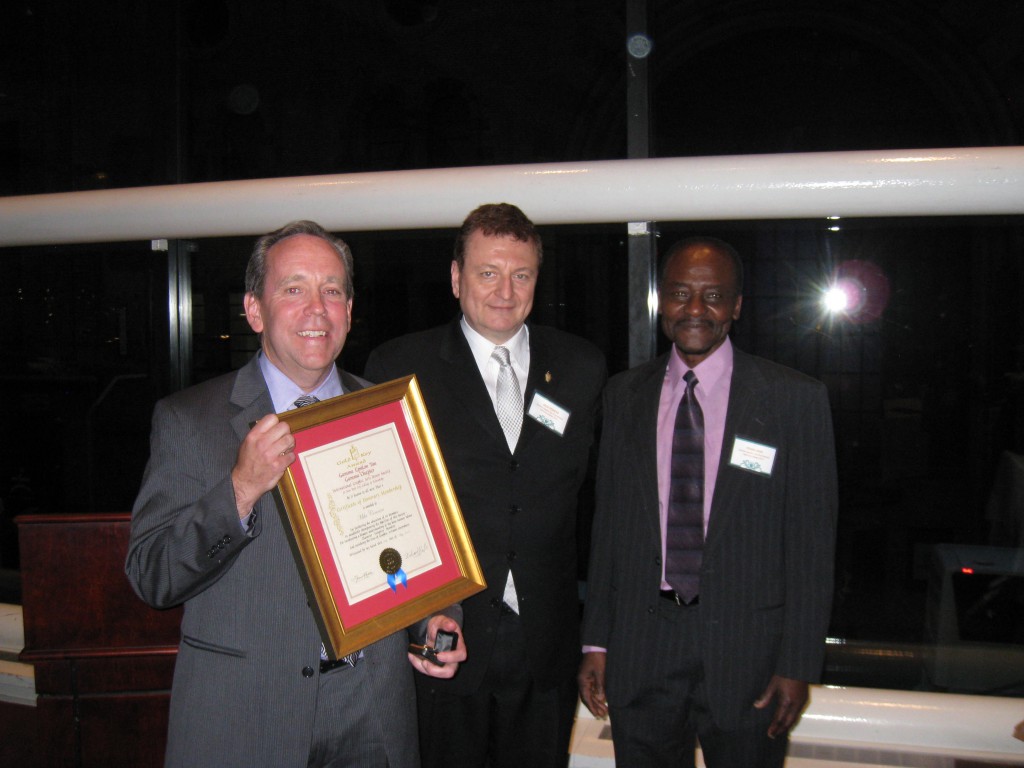The Gamma Chapter of Gamma Epsilon Tau held its Gold Key and Founders Award ceremony in New York City on May 29. The annual event salutes outstanding achievement in graphic communications and promotes the value of higher education in the field.
This year’s honorees were Mike Connors, managing director, production department, The New York Times, who received the Gamma Gold Key Award; and Frank Romano, professor emeritus, Rochester Institute of Technology, selected for the Founders Gold Medal and Citation Award.
Gamma Epsilon Tau is a national fraternity for students of graphic communications, and Gamma chapter is its branch at New York City College of Technology (City Tech). The school’s department of Advertising Design and Graphic Arts (ADGA) has an enrollment of more than 1,000.
The event, organized by ADGA Professor Frank Adae, was held in its customary venue, the 101 Club on Park Avenue in midtown Manhattan. The evening’s master of ceremonies, Jack Powers, noted that the ceremony was taking place in a “big week” for graphics studies at City Tech, a week that also included ADGA’s annual student portfolio review and design competition.
When it comes to education for graphic communications and other high-tech disciplines, “no place in the city is more on top of that than City Tech,” Powers declared. Russell Hotzler, president of City Tech, said that it wouldn’t be possible to provide the quality of education that the school offers without the support of industry members who back its efforts on behalf of students.
Mike Connors (left) accepts the Gamma Gold Key Award from Jack Powers (center) and Prof. Frank Adae (right).
Exemplary among them is Connors, who assists students by hosting plant tours for them at the newspaper’s production facility in College Point, Queens. He also operates a student internship program there, raises funds for learning and physically challenged children, and is active with public-private educational initiatives like PENCIL.
Nick D’Andrea, manager of the College Point plant, cited Connors’s “driving passion to get things done” both professionally and in support of education.
“When you have a task that needs to be done, give it to Mike,” D’Andrea said.
Referring to students in his Gold Key acceptance remarks, Connors spoke of “our obligation as business people and adults to take care of them.” Most important to impress upon young people in graphics studies programs, he said, is that “in our world, it comes down to one word, quality.”
Powers and Adae present the Founders Gold Medal and Citation Award to Frank Romano (left).
Frank Romano, the recipient of the Founders Award, arguably is the most widely known and highly regarded of all specialists in graphic communications. This blogger, called upon to make Romano’s introduction, noted that his name “has become synonymous with higher education for the graphic arts.”
“it doesn’t stretch the truth to say that because of the enormous amounts of source material that he has created for the rest of us to use, he is an invisible presence in every classroom where graphic communications is taught,” we observed.
Romano spoke bluntly both to students and to educators and industry members who are trying to help them build the foundations of their careers.
He told the students that as products of an educational system that graduates 40,000 people trained in graphics every year, “you’d better be really good at making something print.”
But in some cases, Romano warned educators and their industry supporters, “we’re not teaching the right stuff. We’ve failed at that.” He urged everyone with responsibility for educational programs like ADGA’s to be sure that what they are teaching touches all of the bases covered by graphic communications as the industry practices it today.
In the induction ceremony for new student officers of Gamma Chapter, Gamma Epsilon Tau, the lighting of the candles symbolizes the light of knowledge overcoming the darkness of ignorance.
The program concluded with a candle-lighting ceremony that marked the induction of new student officers into Gamma Epsilon Tau’s Gamma Chapter.
The fraternity’s name comes from ancient Greek words representing its purposes and ideals: Gamma for letter, literature, or alphabet; Epsilon, for science or knowledge; and Tau, for art or craft. Thus translated, Gamma Epsilon Tau means “the science or knowledge of the art and craft of letters.”



